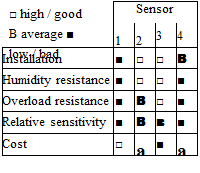 |
 |
Sensors for acoustic emissions to monitor process noise emitted during grinding are vibratory systems, the resonance points of which are determined by their construction. As a result, these sensors, working proportionally to acceleration, represent filter systems that have a dampening or amplifying effect according to the frequency range. The AE sensor thus determines by its frequency behaviour the evaluable frequency spectrum to a great extent. This should be taken into consideration in selecting AE sensors to monitor grinding processes [MEYE91].
Fig. 10-4. The evaluation of AE sensors for process monitoring [MEYE91]
The AE sensors employed in machines in the context of process monitoring must do justice to the highest demands with respect to their resilience. Some typical AE sensors are juxtaposed in Fig. 10-4 [MEYE91]. Especially significant in this context are the aggressive environmental conditions that frequently limit the use of other sensors as well considerably. High temperatures, large quantities of cooling lubricant, abrasive wear from chips or grain abrasion — all demand an extremely robust design of the sensor encasement. Such requirements are fulfilled by the ceramic sensor depicted in Fig. 10-4 (sensor 1), which is also used as a knocking sensor in motor vehicles. Another alternative is offered by AE sensors [N. N.11, N. N.12, N. N.13] that directly record AE signals on the rotating grinding wheel or the workpiece. Sensor 4 is mounted for this purpose directly on the rotating spindle. The measured AE signals are transferred at a maximal rotational speed of 60,000 min-1 without contact to a fixed receiver, which then conveys these signals to an evaluation unit [N. N.11].
